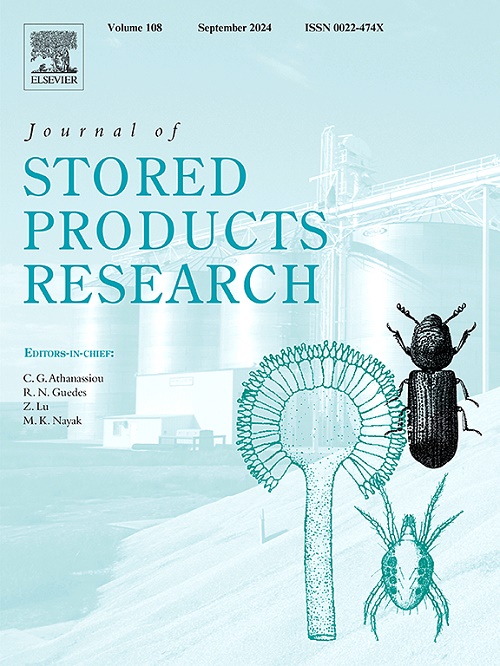硫酰氟的剂量依赖性致死性及马蹄铁(Acari: Cheyletidae)耐受性进化的转录组学研究
IF 2.7
2区 农林科学
Q1 ENTOMOLOGY
引用次数: 0
摘要
利用捕食性螨(Cheyletus malaccensis, Oudemans)防治储粮害虫是一种生态可持续的生物防治策略,而硫酰氟熏蒸是一种有效的化学防治方法。本文探讨了硫酰氟熏蒸与马氏弧菌联合治理储粮害虫的可行性。此外,我们利用转录组学分析来阐明C. malaccensis在胁迫条件下的生理和代谢机制。在相同熏蒸时间下,随着硫酰氟浓度的升高,成虫和虫卵的死亡率均有所上升。熏蒸48 h后成螨LC50约为1.58 g/m3,卵LC50约为26.48 g/m3。当鸡蛋熏蒸时间延长至60 h时,浓度为25 g/m3时,死亡率提高约1.4倍;在15 g/m3浓度下,72 h后死亡率上升3.6倍。蛋类对硫酰氟熏蒸的耐受性高于成虫。在高浓度、长时间的熏蒸环境中,成虫和卵均不能存活。在熏蒸消散后(硫酰氟浓度不超过2.3 g/m3),可释放马拉accensis,使其能够在实际储存设施中有效地建立种群,以便进行长期控制。在转录组数据中,共鉴定出4730个差异表达基因,其中上调3489个,下调1241个。通过GO和KEGG分析发现,参与脂质代谢和能量代谢过程、病原体感染和免疫反应的途径具有显著性。本文章由计算机程序翻译,如有差异,请以英文原文为准。
Dose-dependent lethality of sulfuryl fluoride and transcriptomic insights into tolerance evolution on Cheyletus malaccensis (Oudemans) (Acari: Cheyletidae)
The use of the predatory mite Cheyletus malaccensis (Oudemans) for controlling stored grain pests represents an ecologically sustainable biocontrol strategy, while sulfuryl fluoride fumigation serves as an effective chemical control method. This study investigates the feasibility of combining C. malaccensis with sulfuryl fluoride fumigation to manage stored grain pests. Additionally, we employ transcriptomic analysis to elucidate the physiological and metabolic mechanisms that C. malaccensis engages under stress conditions. Under the same fumigation duration, the mortality rates of both adult and egg increased with higher concentrations of sulfuryl fluoride. The LC50 for adult mites after 48 h of fumigation was approximately 1.58 g/m3, while the LC50 for egg was around 26.48 g/m3. When the fumigation time for egg was extended to 60 h, the mortality rate at a concentration of 25 g/m3 increased by approximately 1.4 times; after 72 h, the mortality rate at 15 g/m3 rose by 3.6 times. Egg exhibited greater tolerance to sulfuryl fluoride fumigation compared to adult. Neither adult nor egg could survive in high-concentration, long-duration fumigation environments. C. malaccensis can be released after the fumigation has dissipated (with sulfuryl fluoride concentrations not exceeding 2.3 g/m3), allowing it to effectively establish populations in real storage facilities for long-term control. In the transcriptome data, a total of 4730 differentially expressed genes were identified, including 3489 upregulated and 1241 downregulated genes. Through GO and KEGG analysis, it was found that the pathways involved in lipid metabolism and energy metabolism processes, pathogen infection and immune response were significant.
求助全文
通过发布文献求助,成功后即可免费获取论文全文。
去求助
来源期刊
CiteScore
5.70
自引率
18.50%
发文量
112
审稿时长
45 days
期刊介绍:
The Journal of Stored Products Research provides an international medium for the publication of both reviews and original results from laboratory and field studies on the preservation and safety of stored products, notably food stocks, covering storage-related problems from the producer through the supply chain to the consumer. Stored products are characterised by having relatively low moisture content and include raw and semi-processed foods, animal feedstuffs, and a range of other durable items, including materials such as clothing or museum artefacts.

 求助内容:
求助内容: 应助结果提醒方式:
应助结果提醒方式:


